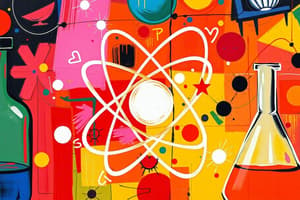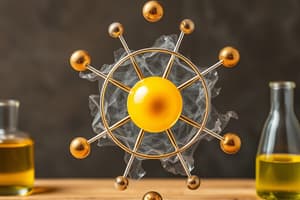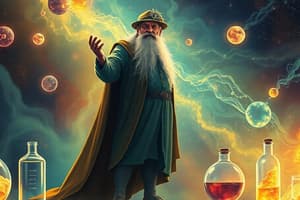Podcast
Questions and Answers
What does Democritus's Atomic Theory state about matter?
What does Democritus's Atomic Theory state about matter?
- Matter is composed of empty space through which atoms move. (correct)
- Matter is composed of elements that cannot be divided.
- Different atoms have the same sizes and shapes.
- Atoms are only made of solid materials.
Which of the following is NOT a part of Dalton's Atomic Theory?
Which of the following is NOT a part of Dalton's Atomic Theory?
- Atoms of the same element are identical.
- Atoms can be created or destroyed. (correct)
- All matter is composed of atoms.
- Different atoms combine in whole number ratios.
Why is Dalton's atomic theory slightly wrong?
Why is Dalton's atomic theory slightly wrong?
Atoms can have slightly different masses and are divisible into smaller subatomic particles.
What is an atom?
What is an atom?
What is a cathode ray?
What is a cathode ray?
What is an anode?
What is an anode?
What is an electron?
What is an electron?
Who determined the charge of the electron?
Who determined the charge of the electron?
What was discovered by J.J. Thomson in 1897?
What was discovered by J.J. Thomson in 1897?
The mass of an electron is ___.
The mass of an electron is ___.
What does the plum pudding model suggest?
What does the plum pudding model suggest?
What does Rutherford's nuclear atomic model explain?
What does Rutherford's nuclear atomic model explain?
What are protons?
What are protons?
The mass of a proton is ___.
The mass of a proton is ___.
What is the atomic number?
What is the atomic number?
What is the mass number?
What is the mass number?
What are isotopes?
What are isotopes?
What is average atomic mass?
What is average atomic mass?
What is radioactivity?
What is radioactivity?
Alpha radiation is made up of ___ particles.
Alpha radiation is made up of ___ particles.
What is a nuclear equation?
What is a nuclear equation?
What is transmutation?
What is transmutation?
What is the difference between chemical reactions and nuclear reactions?
What is the difference between chemical reactions and nuclear reactions?
What are gamma rays?
What are gamma rays?
Flashcards are hidden until you start studying
Study Notes
Democritus's Atomic Theory
- Matter consists of empty space allowing atom movement.
- Atoms are solid, homogeneous, indestructible, and indivisible.
- Varying shapes and sizes of atoms account for different matter properties.
Dalton's Atomic Theory
- All matter is made of tiny atoms.
- Atoms of an element are identical in size and mass; different elements have different atoms.
- Atoms cannot be created, divided, or destroyed.
- Atoms combine in simple whole-number ratios to form compounds.
- During chemical reactions, atoms are rearranged.
Limitations of Dalton's Theory
- Recognizes that atoms have slightly different masses and are divisible into subatomic particles.
Atom Definition
- The smallest particle of an element which retains its chemical identity.
Cathode Ray
- A beam of electrons produced by the cathode in an electrical discharge tube.
Cathode
- The negatively charged electrode from which electrons are emitted.
Anode
- The positively charged electrode through which electrons exit the device.
Electron
- A negatively charged particle located outside the atomic nucleus.
Robert Milikan
- Known for measuring the charge of the electron.
J.J. Thomson
- Discovered electrons in 1897 using cathode rays and positively charged plates; proposed the "plum pudding model."
Mass of an Electron
- Approximately 1/1840 of a proton's mass.
Plum Pudding Model
- Suggests electrons are spread within a uniform positive charge.
Rutherford's Nuclear Atomic Model
- Based on gold foil experiment results; alpha particles mostly pass through with minor deflections.
- Identified a dense positive nucleus responsible for deflections of alpha particles.
Proton
- A subatomic particle with a positive charge, essential to atomic structure, discovered by Rutherford.
Mass of a Proton
- Proton's mass is approximately 1 atomic mass unit (amu).
Neutron
- A subatomic particle with no electrical charge, identical mass to a proton.
Electron Cloud
- A probability region around an atomic nucleus where electrons are likely found.
Atomic Number
- Indicates the number of protons in an atom's nucleus, determining the element's identity.
Mass Number
- Total count of protons and neutrons in an atomic nucleus.
Isotopes
- Variations of the same element differing in neutron count.
Average Atomic Mass
- A weighted average reflecting the atomic mass of isotopes based on their abundance.
Atomic Mass Unit (amu)
- Defined as one-twelfth the mass of a carbon-12 atom.
Atomic Mass
- The average of the mass numbers of an element's isotopes.
Nuclear Reactions
- Involve splitting or fusing atomic nuclei, producing significant energy compared to chemical reactions.
Radioactivity
- The spontaneous emission of radiation from certain substances.
Radiation
- Energy emitted in the form of rays, waves, or particles.
Radioactive Decay
- The release of nuclear particles and energy from unstable atomic nuclei.
Alpha Radiation
- Composed of alpha particles, deflected toward a negatively charged plate in electric fields.
Alpha Particles
- Formed from two protons and two neutrons; equivalent to a helium-4 nucleus.
Alpha Particle Properties
- Largest radioactive particle with limited range; most damaging due to mass.
Nuclear Equations
- Represent changes involving atomic and mass numbers in radioactive processes.
Beta Radiation
- Involves the emissions of beta particles during decay.
Beta Particles
- Electrons emitted from neutron decay; low mass and charge of -1, moderate penetrating power.
Effects of Alpha Particle Emission
- Results in a decrease of mass number by 4 and atomic number by 2.
Conservation in Nuclear Equations
- Mass numbers and atomic numbers must balance on both sides of the equation.
Beta Decay Process
- A neutron converts into a proton and emits an electron, leaving the mass number unchanged while increasing the atomic number by 1.
Transmutation
- The transformation of one element into another via radioactive decay.
Chemical vs. Nuclear Reactions
- Chemical reactions affect electron arrangements; nuclear reactions involve changes in the atomic nucleus.
Gamma Rays
- High-energy electromagnetic radiation with no mass or charge; highly penetrating and not deflected in fields.
Studying That Suits You
Use AI to generate personalized quizzes and flashcards to suit your learning preferences.




